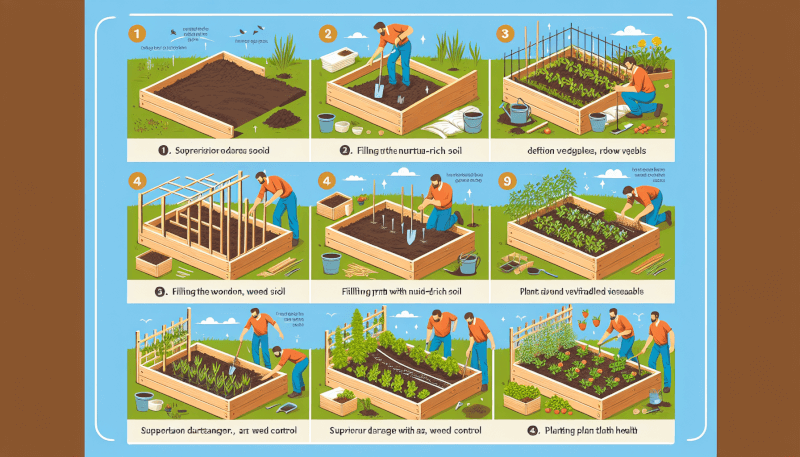So, you’ve always wanted to have your own garden, but you don’t have much space or the best soil quality for planting? Fear not, because we’ve got the perfect solution for you: a raised bed garden! In just 10 easy steps, you can build your very own raised bed garden and start growing your favorite fruits, vegetables, and herbs right in your backyard. With this handy guide, we’ll walk you through everything you need to know to create a beautiful and functional garden space that will have your neighbors green with envy.
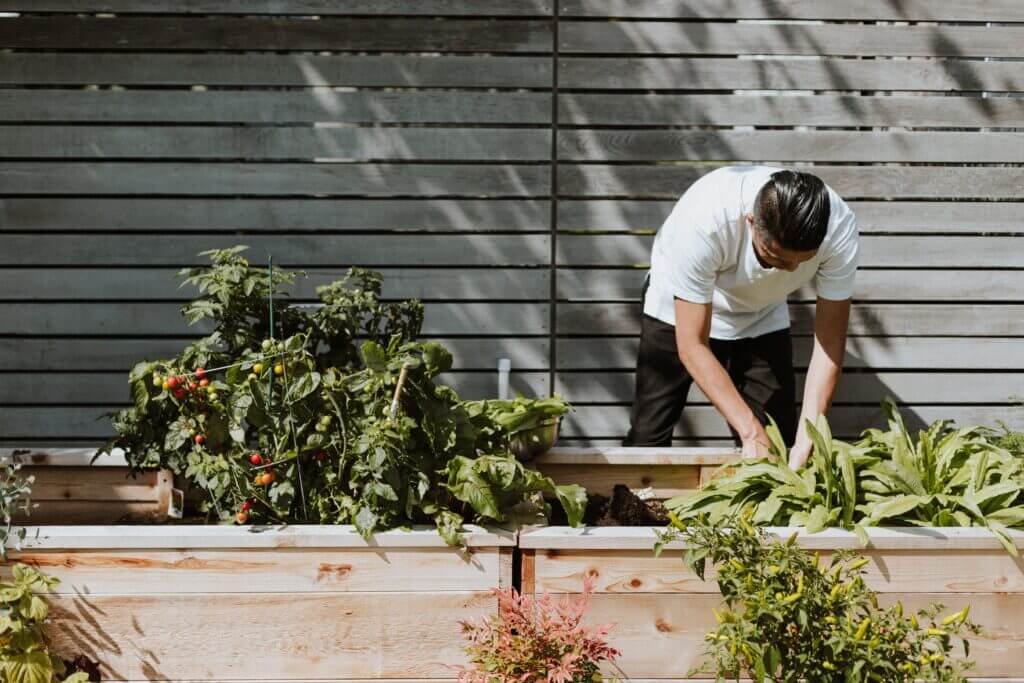
Choosing the Right Location
Consider sunlight exposure
When choosing the location for your raised bed garden, it is essential to consider the amount of sunlight exposure it will receive. Most vegetable plants require at least six to eight hours of direct sunlight each day to thrive. Take note of any nearby trees or structures that may cast shadows on your garden and choose a spot that receives ample sunlight throughout the day.
Evaluate soil drainage
Another crucial factor to consider when selecting a location for your raised bed garden is soil drainage. The soil in the garden bed should have good drainage to prevent waterlogged roots, which can lead to root rot and other plant diseases. Choose an area of your yard that is not prone to flooding and where the water drains away easily after rain.
Ensure accessibility
Accessibility is an important aspect to keep in mind when choosing the location for your raised bed garden. Select a spot that is convenient for you to reach and maintain. Consider factors such as proximity to a water source, ease of access for watering and harvesting, and even the proximity to your home for easier monitoring and care.
Determining the Size and Shape
Consider available space
Before you start building your raised bed garden, evaluate the available space you have in your yard. Take into account any existing structures, trees, or plants that may limit the size or shape of your garden bed. Ensure that the area you choose is large enough to accommodate the types of plants you want to grow and provides ample room for maintenance and access.
Calculate the dimensions
Once you have determined the available space, it’s time to calculate the dimensions of your raised bed garden. Consider the length, width, and height of your garden bed, keeping in mind that the height should be at least 12 inches for optimal root growth. Calculate the dimensions based on your available space, making sure to leave enough room between beds for easy navigation and maintenance.
Select the shape
The shape of your raised bed garden is a matter of personal preference and aesthetics. You can choose from rectangular, square, circular, or even custom designs. Consider the overall layout of your yard and how the raised bed garden will fit into the existing landscape. Remember that a rectangular or square shape is generally easier to build and maintain, while circular or custom shapes may require more planning and materials.
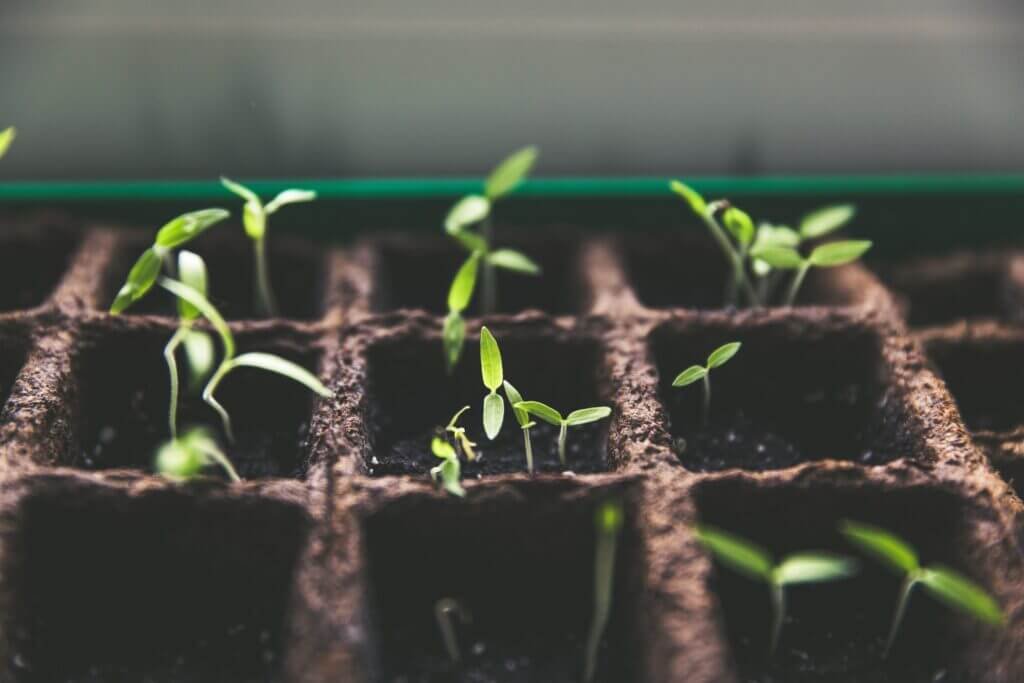
Preparing the Ground
Clear the area
Before building your raised bed garden, it is essential to clear the area of any vegetation or debris. Remove any grass, weeds, or rocks that may inhibit the growth of your plants. You can use a shovel, rake, or even a weed trimmer to clear the area effectively. Take the time to ensure that the ground is level and free from any obstructions that may affect the stability of your garden bed.
Lay a weed barrier
To prevent weeds from growing in your raised bed garden, lay a weed barrier before filling it with soil. You can use landscape fabric or weed-blocking plastic to cover the bottom of the garden bed. This will help suppress weed growth and keep your garden beds low maintenance.
Level the ground
Before proceeding with building your raised bed garden, ensure that the ground is level. Use a level or a straight piece of wood to check that the surface is even. A level ground will provide stability to your garden bed and prevent any tilting or shifting over time. Make any necessary adjustments to ensure a level base for your raised bed garden.
Building the Frame
Select the material
When it comes to selecting the material for your raised bed garden frame, there are various options to choose from. Popular choices include wood, metal, and concrete blocks. Wood is a common and versatile option that is easy to work with and readily available. Ensure that the wood you choose is untreated and resistant to rotting. Metal frames, such as corrugated steel or aluminum, offer durability and a modern look. Concrete blocks provide strength and stability but may require some masonry skills for construction.
Cut the boards
If you choose to build your raised bed garden with wood, you will need to cut the boards to the desired length. Measure and mark the boards according to your calculated dimensions. Using a saw, carefully cut the boards to size, ensuring smooth and even cuts. Remember to wear safety goggles and gloves when handling tools and cutting materials.
Construct the frame
With the boards cut to size, it’s time to construct the frame of your raised bed garden. Lay out the boards according to your planned dimensions, ensuring that they fit together snugly. Use screws or nails to secure the corners and sides of the frame, creating a sturdy structure. Check that the frame is level and square before proceeding to the next step.
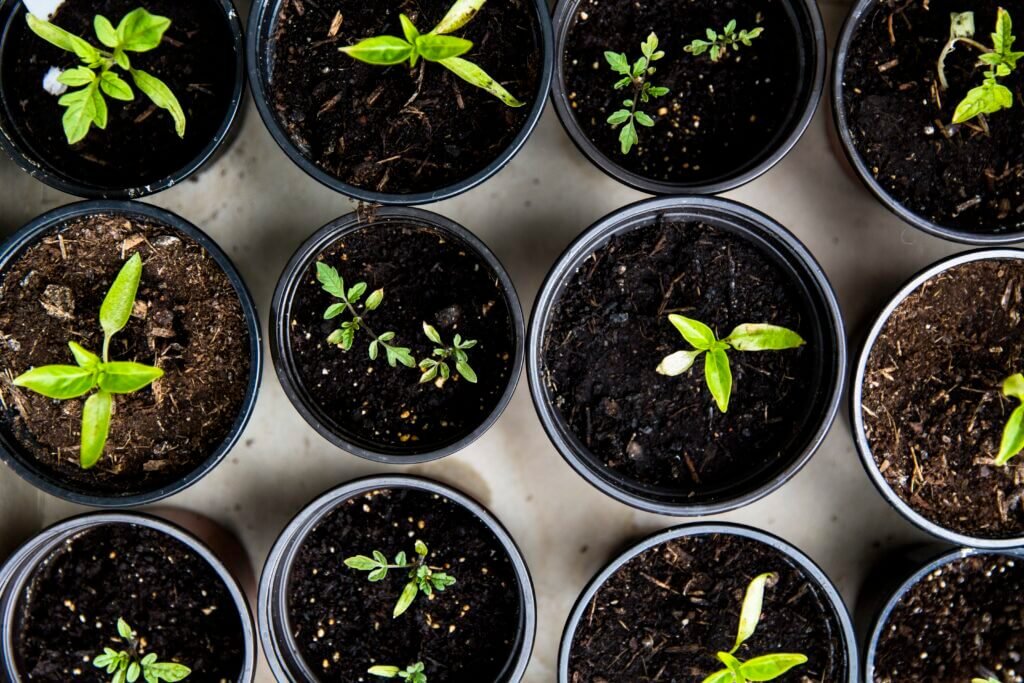
Filling the Bed with Soil
Choose the soil mix
Selecting the right soil mix is crucial for the success of your raised bed garden. Opt for a mix that is loose, well-draining, and rich in organic matter. A typical soil mix for raised bed gardens consists of equal parts garden soil, compost, and a soil amendment such as perlite or vermiculite. Avoid using heavy clay soil or sandy soil that does not retain moisture or provide sufficient nutrients for your plants.
Prepare the soil
Before filling your raised bed garden with soil, prepare the soil by loosening it with a garden fork or tiller. Break up any clumps and remove any large rocks or debris. This will help improve aeration and ensure that the soil is loose and workable. Consider adding additional organic matter such as compost or aged manure to enrich the soil and provide essential nutrients.
Fill the bed
Once your soil is prepared, it’s time to fill your raised bed garden. Begin by layering a few inches of the soil mix at the bottom of the garden bed. Spread it evenly and compact it lightly to ensure a solid base. Continue adding soil in layers, gradually filling the entire bed while ensuring that it is level and evenly distributed. Leave a few inches of space at the top to allow for watering and mulching.
Adding Amendments
Test the soil
Before adding amendments to your raised bed garden, it is recommended to test the soil for its nutrient levels and pH. Soil testing kits are readily available at garden centers and can provide valuable information about your soil’s composition. Based on the test results, you can determine the specific amendments needed to optimize the soil conditions for your plants.
Add organic matter
Adding organic matter to your raised bed garden helps improve soil fertility and structure. It increases the soil’s ability to retain moisture, promotes beneficial microbial activity, and provides essential nutrients. Common organic matter amendments include compost, aged manure, leaf mold, and worm castings. Spread a layer of organic matter over the top of the soil and gently mix it in with a garden fork or shovel.
Incorporate compost
Compost is a valuable addition to any raised bed garden. It acts as a natural fertilizer, enriching the soil with nutrients and promoting healthy plant growth. Spread a layer of compost over the top of the soil and gently mix it in with a garden fork or shovel. Be sure to choose compost that is well-aged and free from weed seeds or pathogens.
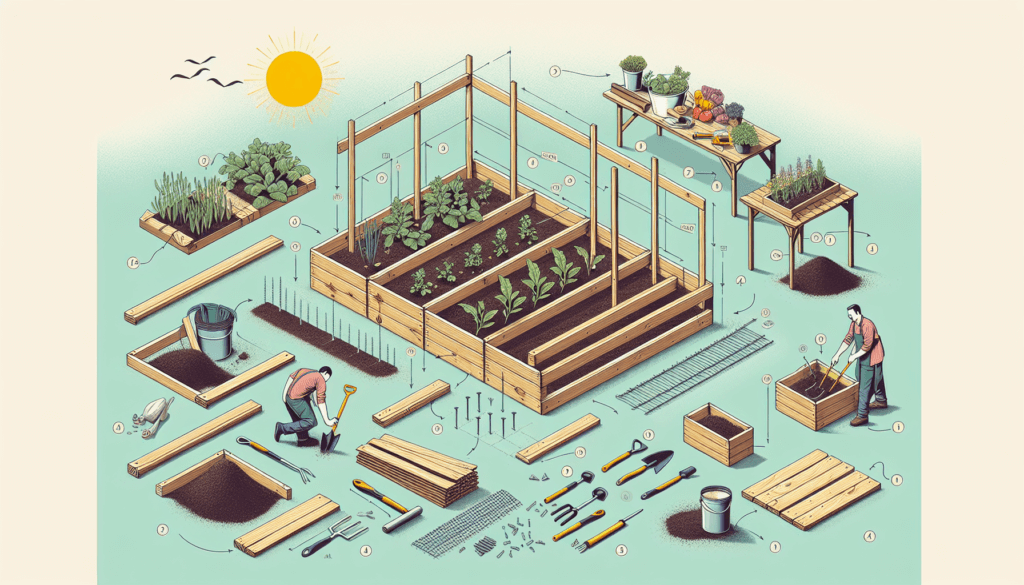
Installing Irrigation
Choose the irrigation system
Installing an irrigation system in your raised bed garden makes watering more efficient and convenient. There are several options to choose from, including drip irrigation, soaker hoses, and sprinkler systems. Drip irrigation is highly recommended for raised bed gardens as it provides targeted water delivery directly to the plant roots, minimizing water waste and reducing the risk of fungal diseases.
Install drip lines
To install a drip irrigation system, lay out the main water line along the length of your raised bed garden. Connect the drip lines, which typically have tiny holes or emitters spaced evenly, to the main water line. Position the drip lines above the soil surface, ensuring that they are close to the base of the plants. Secure the drip lines with stakes or clips to keep them in place.
Set up a timer
To automate the watering process, install a timer for your drip irrigation system. This allows you to set specific watering schedules and ensures that your plants receive a consistent water supply. Adjust the timer settings based on the needs of your plants and the weather conditions. Regularly monitor the moisture levels in your raised bed garden to make any necessary adjustments to the watering schedule.
Selecting the Plants
Consider the climate
When selecting plants for your raised bed garden, it’s important to consider the climate in your area. Different plants thrive under various temperature and weather conditions, so choose plants that are suitable for your specific climate. Consider factors such as average temperature ranges, humidity levels, and the length of the growing season. Research which plants are best suited for your region and choose accordingly.
Choose suitable plants
When choosing plants for your raised bed garden, consider your gardening goals, taste preferences, and available space. Opt for plants that you enjoy eating or plants that are visually appealing to you. Consider the size and growth habits of the plants to ensure they fit within the dimensions of your raised bed garden. Think about companion planting and choose plants that have compatible growing requirements.
Plan for crop rotation
To maintain soil fertility and prevent disease buildup, it is essential to plan for crop rotation in your raised bed garden. Avoid planting the same family of plants in the same bed consecutively. Instead, rotate your crops each season, following a three or four-year cycle. This helps minimize nutrient depletion and reduces the risk of pests and diseases specific to certain plant families.
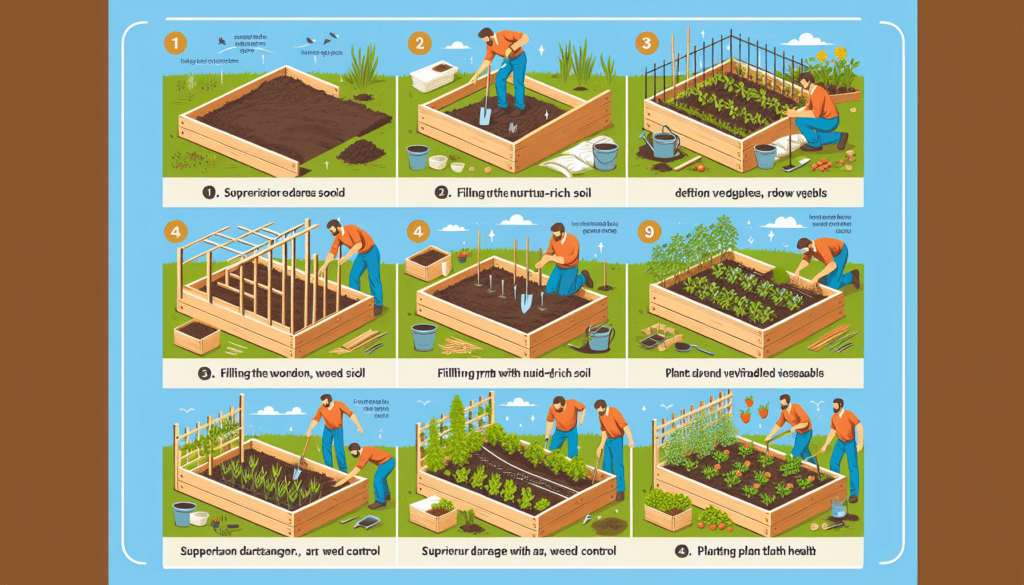
Planting and Caring for the Garden
Follow proper spacing
When planting in your raised bed garden, it is crucial to follow proper spacing guidelines to ensure optimal growth and productivity. Each plant has specific spacing requirements based on its size and growth habits. Overcrowding can lead to competition for nutrients, moisture, and light, resulting in stunted growth and increased susceptibility to pests and diseases. Refer to seed packets or plant labels for recommended spacing distances.
Provide mulch
Mulching your raised bed garden has numerous benefits. It helps conserve moisture, suppresses weed growth, and regulates soil temperature. Apply a layer of organic mulch, such as straw, wood chips, or dried leaves, over the soil surface around your plants. Ensure that the mulch is a few inches thick, leaving some space around the plants’ stems to prevent moisture buildup and potential rotting.
Water and fertilize the plants
Watering and fertilizing your plants appropriately is essential for their overall health and productivity. Water your raised bed garden regularly, ensuring that the soil stays consistently moist but not waterlogged. Avoid overhead watering, which can promote diseases. Instead, aim to water at the base of the plants using a watering can or a drip irrigation system.
Fertilize your raised bed garden with a balanced organic fertilizer or compost tea to provide the necessary nutrients for plant growth. Follow the manufacturer’s instructions for application rates and frequency. Monitor your plants for any signs of nutrient deficiencies or imbalances and make adjustments as needed.
Managing Pests and Diseases
Implement preventive measures
Preventing pests and diseases is vital in maintaining a healthy raised bed garden. Implementing preventive measures can help reduce the risk of infestations and damage. Monitor your plants regularly for any signs of pests or diseases and take immediate action if necessary. Maintaining proper spacing between plants, providing adequate airflow, and practicing good garden hygiene can help minimize the likelihood of pests and diseases.
Identify common garden pests
Familiarize yourself with common garden pests that may affect your raised bed garden. Some common pests include aphids, caterpillars, slugs, snails, and tomato hornworms. Learn to identify these pests and their damage symptoms. Consider using physical barriers, such as row covers or netting, to protect your plants from pest infestations.
Use organic pest control methods
When dealing with pests and diseases in your raised bed garden, opt for organic pest control methods. Chemical pesticides can harm beneficial insects and disrupt the natural ecosystem of your garden. Instead, consider using natural pest control solutions such as insecticidal soaps, neem oil, or homemade repellents. Encourage beneficial insects, such as ladybugs and lacewings, by planting flowers that attract them.
By following these steps and guidelines, you can successfully build and maintain your own raised bed garden. Enjoy the process of planting, growing, and harvesting your favorite fruits and vegetables while creating a beautiful and productive garden space. Happy gardening!

